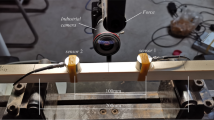Abstract
Physical interpretation of the three characteristic groups of acoustic signals emitted during convective drying of wood is the main subject of this paper. The acoustic emission (AE) was to evidence the fracture intensity during drying of a birch wood sample of cylindrical shape. To explain the three characteristic groups of acoustic signals, and particularly the last one, a mechanistic model of drying was applied to analyse the drying induced stresses in the tested sample. One can conclude from this analysis that the third group of acoustic signals arises when the surface stop to shrink and the wet core (initially in compression) begins to dry. The shrinkage of the core causes compression of the boundary layer and tension of the core. Thus, the reverse of the stress signs in the cylinder cross-section takes place and this possibly involves the destruction of wood structure in the tensed core.














Similar content being viewed by others
References
Bazant ZP (1985) Constitutive equation of wood at variable humidity and temperature. Wood Science and Technology 19:159–177
Cunderlik I, Moliński W and Raczkowski J (1996) The monitoring of drying cracks in the tension and opposite wood by acoustic emission and scanning electron microscopy method. Holtzforschung 50(3):258–262
Dzbeński W (1984) Non-destructive examinations of mechanical properties of wood with the use of static and dynamic methods. SGGW, Warsaw
Honeycutt RM, Skaar C and Simpson WT (1985) Use of acoustic emission to control drying rate of red oak. Prod J 35(1):48–50
Kagawa Y, Noguchi M and Katagiri J (1980) Detection of acoustic emission in the process of timber drying. Acoust Lett 3(8):150–153
Kania S (1990) Heat transfer through wood materials. Scientific Papers of the Institute of Building of the Technical University of Wrocław, series monographs No. 23
Kitayama S, Noguchi M and Satoyoshi K (1985a) Monitoring of wood drying process by acoustic amission. Wood Ind 40(10):464–469
Kitayama S, Noguchi M, Satoyoshi K (1985b) Automatic control system of drying Zelkova wood by acoustic emission monitoring. Acoust Lett 9(4):45–48
Kowalski SJ (1996) Drying processes involving permanent deformations of dried materials. Int J Engin Sci 34(13):1491–1506
Kowalski SJ (2000) Towards a thermodynamics and mechanics of drying processes. Chem Engin Sci 55:1289–1304
Kowalski SJ, Kowal M (1998a) Physical relation for wood at variable humidity. Trans Por Med 31:331–346
Kowalski SJ, Kowal M (1998b) Material constants for wet pine sapwood. Studia Geotechnica et Mechanica 22(3–4):39–52
Kowalski SJ, Musielak G (1999) Deformations and stresses in dried wood. Trans Por Med 34:239–248
Kowalski SJ, Musielak G and Rybicki A (1997) Response of dried materials on drying conditions. Int J Heat Mass Transfer 40(5):1217–1226
Kowalski SJ, Rajewska K and Rybicki A (2000) Destruction of wet materials by drying. Chem Engin Sci 55:5755–5762
Milota MR, Qinglin W (1994) Resolution of the stress and strain components during drying of softwood. In: Proceedings of the 9th International Drying Symposium (IDS’94), Queensland, Australia, 1–4 August 1994
Moliński W (1998) Detection of cracks development in wood with using the acoustic emission method (EA). Reports of Agriculture Academy in Poznań, No. 288
Niemz P, Bernatowicz G and Matejak M (1990) Orientierende Untersuchungen zur Anwendung der Schalemissionanalyse bei der Holtztroknung. In: Proceedings of the 8th International Symposium, Fundamental Research of Wood, 202–206, Warsaw
Noguchi M, Kagawa Y and Katagiri J (1980) Detection of acoustic emission during hardwood drying. Mokuzai Gakkaishi, 26(9):637–638
Ranta-Maunus A (1975) The viscoelasticity of wood at varying moisture content. Wood Science and Technology 9:189–205
Skaar C, Simpson WT and Honeycutt RM (1980) Use of acoustic emission to identify high levels of stress during oak lumber drying. For Prod J 30(2):21–22
Acknowledgements
This work was carried out as a part of research project No 7 T09C 035 21, sponsored by the Polish State Committee for Scientific Research in the years 2001–2004.
Author information
Authors and Affiliations
Corresponding author
Rights and permissions
About this article
Cite this article
Kowalski, S.J., Moliński, W. & Musielak, G. The identification of fracture in dried wood based on theoretical modelling and acoustic emission. Wood Sci Technol 38, 35–52 (2004). https://doi.org/10.1007/s00226-003-0211-7
Received:
Published:
Issue Date:
DOI: https://doi.org/10.1007/s00226-003-0211-7




